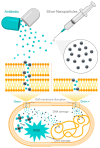Metallic Structures: Effective Agents to Fight Pathogenic Microorganisms
- PMID: 35163090
- PMCID: PMC8835760
- DOI: 10.3390/ijms23031165
Metallic Structures: Effective Agents to Fight Pathogenic Microorganisms
Abstract
The current worldwide pandemic caused by coronavirus disease 2019 (COVID-19) had alerted the population to the risk that small microorganisms can create for humankind's wellbeing and survival. All of us have been affected, directly or indirectly, by this situation, and scientists all over the world have been trying to find solutions to fight this virus by killing it or by stop/decrease its spread rate. Numerous kinds of microorganisms have been occasionally created panic in world history, and several solutions have been proposed to stop their spread. Among the most studied antimicrobial solutions, are metals (of different kinds and applied in different formats). In this regard, this review aims to present a recent and comprehensive demonstration of the state-of-the-art in the use of metals, as well as their mechanisms, to fight different pathogens, such as viruses, bacteria, and fungi.
Keywords: antimicrobial agents; bacteria; fungi; metals; virus.
Conflict of interest statement
The authors declare no conflict of interest.
Figures


Similar articles
-
Recent Advances in Metal-Based Antimicrobial Coatings for High-Touch Surfaces.Int J Mol Sci. 2022 Jan 21;23(3):1162. doi: 10.3390/ijms23031162. Int J Mol Sci. 2022. PMID: 35163084 Free PMC article. Review.
-
Nanoparticles and their antimicrobial properties against pathogens including bacteria, fungi, parasites and viruses.Microb Pathog. 2018 Oct;123:505-526. doi: 10.1016/j.micpath.2018.08.008. Epub 2018 Aug 7. Microb Pathog. 2018. PMID: 30092260 Review.
-
New molecular strategies for reducing implantable medical devices associated infections.Curr Med Chem. 2014;21(29):3375-82. doi: 10.2174/0929867321666140304103810. Curr Med Chem. 2014. PMID: 24606502 Review.
-
Imaging, Identification and Inhibition of Microorganisms Using AIEgens.Top Curr Chem (Cham). 2021 Apr 9;379(3):21. doi: 10.1007/s41061-021-00333-x. Top Curr Chem (Cham). 2021. PMID: 33835299 Review.
-
Antimicrobial Lipstick: Bio-Based Composition against Viruses, Bacteria, and Fungi.ACS Appl Mater Interfaces. 2022 Dec 28;14(51):56658-56665. doi: 10.1021/acsami.2c19460. Epub 2022 Dec 14. ACS Appl Mater Interfaces. 2022. PMID: 36516340
Cited by
-
Silver and Antimicrobial Polymer Nanocomplexes to Enhance Biocidal Effects.Int J Mol Sci. 2024 Jan 19;25(2):1256. doi: 10.3390/ijms25021256. Int J Mol Sci. 2024. PMID: 38279254 Free PMC article.
-
Biochemical Behavior, Influence on Cell DNA Condition, and Microbiological Properties of Wool and Wool-Copper Materials.Materials (Basel). 2024 Jun 12;17(12):2878. doi: 10.3390/ma17122878. Materials (Basel). 2024. PMID: 38930247 Free PMC article.
-
Frontiers in Antimicrobial Materials.Int J Mol Sci. 2022 Jul 21;23(14):8047. doi: 10.3390/ijms23148047. Int J Mol Sci. 2022. PMID: 35887389 Free PMC article.
-
Bio-functionalized nickel-silica nanoparticles suppress bacterial leaf blight disease in rice (Oryza sativa L.).Front Plant Sci. 2023 Aug 2;14:1216782. doi: 10.3389/fpls.2023.1216782. eCollection 2023. Front Plant Sci. 2023. PMID: 37655220 Free PMC article.
-
Nanostructured Antibiotics and Their Emerging Medicinal Applications: An Overview of Nanoantibiotics.Antibiotics (Basel). 2022 May 25;11(6):708. doi: 10.3390/antibiotics11060708. Antibiotics (Basel). 2022. PMID: 35740115 Free PMC article. Review.
References
-
- Selvamani V., Zareei A., Elkashif A., Maruthamuthu M.K., Chittiboyina S., Delisi D., Li Z., Cai L., Pol V.G., Seleem M.N., et al. Hierarchical Micro/Mesoporous Copper Structure with Enhanced Antimicrobial Property via Laser Surface Texturing. Adv. Mater. Interfaces. 2020;7:1901890. doi: 10.1002/admi.201901890. - DOI
-
- Kefallinou D., Ellinas K., Speliotis T., Stamatakis K., Gogolides E., Tserepi A. Optimization of Antibacterial Properties of “Hybrid” Metal-Sputtered Superhydrophobic Surfaces. Coatings. 2019;10:25. doi: 10.3390/coatings10010025. - DOI
Publication types
MeSH terms
Substances
Grants and funding
LinkOut - more resources
Full Text Sources

